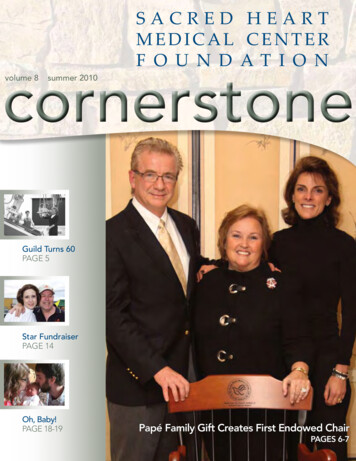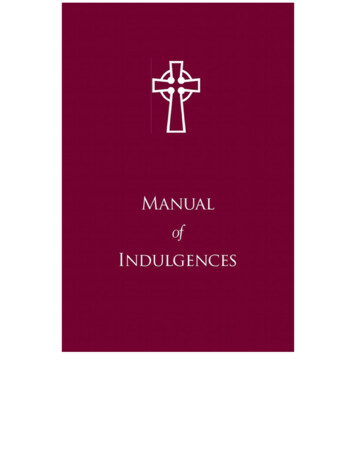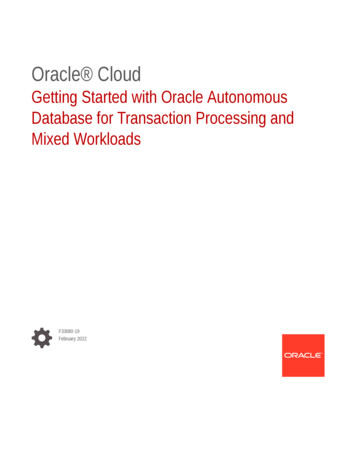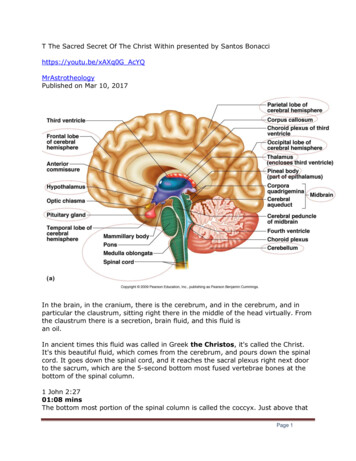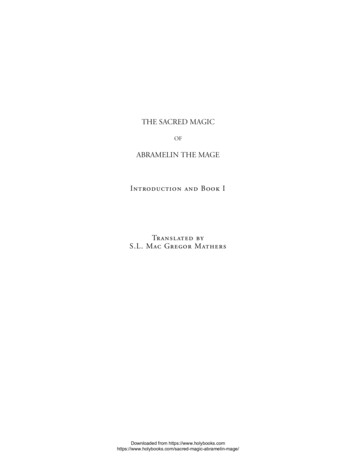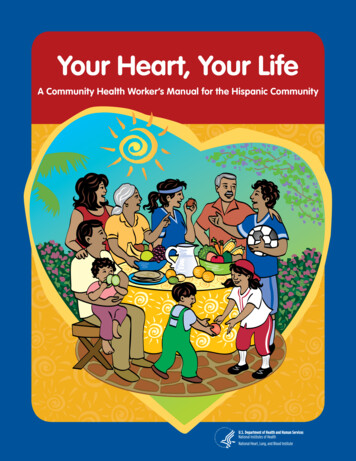
Transcription
SACRED HEART COLLEGE (AUTONOMOUS)Department of BOTANYMASTER OF SCIENCE IN BOTANYCourse planAcademic Year 2014 – 15Semester 2
GYMNOSPERMS, EVOLUTION & DEVELOPMENTAL BIOLOGY.Basic Reference1Andrews H N Jr (1961). Studies in Palaeobotany. John Wiley and sons.2. Arnold C A (1947). An introduction to Palaeobotany. John Wiley and sons.3. Beck C E (1995). Gymnosperm Phylogeny. Bot. Rev. 51-176.4. Bhatnagar S P, Moitra A (2000). Gymnosperms. New Age International Ltd.5. Chamberlain C J (1935). Gymnosperms: Structure and Evolution. University of ChicagoPress.6. Monroe W Strickberger (1990). Evolution. Jones and Bartlett publishers.7. Agashe, S.N. (1995), Palaeobotany, Oxford & IBH, New Delhi.8. Siddiqui, K.A. (2002) Elements of Palaeobotany, Kitab Mahal, Allahabad.9. Thomas, B.A. & Spicer R.A. (1987): The Evolution and Palaeobiology of land plants.Discordies Press, Fortland, USA.1.DateTopicMethod1Session 1Origin, general characteristics,Presentation/Chalk2.Session 2distribution and classification ofBoardRemarks/ReferenceandGymnosperms (K R Sporne andC J Chamberlain). Distribution ofliving gymnosperms in India.DNA barcoding of gymnosperms.3Session 3Detailed study of the vegetativePresentation/Chalk4Session 4morphology, internal structure,Board/Assignment5Session 5reproductive structures, and6Session 67Session 78Session 89Session 9Progymnospermopsida:10Session 10Aneurophyton11Session 11(b)12Session 12Heterangium, Lyginopteris,13Session 13Lagenostoma, Glossopteris,14Session 1415Session 15evolution of the orders andfamilies (with reference to thegenera mentioned).(a)ClassClass Cycadopsida:Medullosa, Caytonia. Bennettites,and
16Session 16Williamsoniella, Nilsonia, Cycas,17Session 17Zamia, Pentoxylon.18Session 18(c)Class Coniferopsida:General account of families underConiferales, range of form andstructure of stem, leaves; range ofform, structure and evolution offemale cones in coniferales suchas Pinus, Taxodium, Cupressus,Podocarpus, Agathis, Araucaria,Taxus and Ginkgo.(d)Class Gnetopsida:Gnetum.19Session 19(a)General account on the Presentation/Chalk20Session 2021Session 21male and female gametophyte Boarddevelopment in Gymnospermsand(Cycas).(b)Economic importance ofGymnosperms22Session 22Abiogenesis,23Session 23experiment24Session 2425Session 25Biogenesis Presentation/ChalkofandMiller(1953). BoardTheory of Organic evolution Biochemical origin of life, placeandtimeoforiginandexperimental evidences. Conceptof Oparin and Haldane.26Session 2627Session 2728Session 2829Session 29History of Character Evolution,Patterns of Evolutionary changeexplained from systematics,Phylogeny and patterns ofEvolution, Adaptive radiation,Patterns in genes and genomesPresentation/ChalkBoard/Assignmentand
30Session 3031Session 3132Session 3233Session 3334Session 3435Session 3536Session 3637Session 3738Session 3839Session 3940Session 4041Session 4142Session 4243Session 4344Session 4445Session 4546Session 46Biodiversity, Genetic variation,phenotypic variation, evolutionof life histories, Macro evolution;evolution above the species level.Sex and Reproductive success;Paradox of sex, Inbreeding andoutcrossing, Concept of sexualselection, sexual selection bymate choice.Genetic drift - Salient features;species concept; sub-species,sibling species, semi species,demes. Types of speciation Phyletic speciation and Truespeciation.Mechanismofspeciation - Genetic divergencesandisolatingmechanisms.Patterns of speciation - allopatric,sympatric,quantumandparapatric speciation.Presentation/ChalkNatural selection and adaptation;nature of Natural Selection,examples of NS, levels ofselection, nature of adaptations,The Genetical theory of naturalselection; Fitness, models tion, multiple outcomes ofevolutionary change, the strengthof NS, molecular signatures ofNS.Presentation/ChalkModern synthetic theory ofevolution, molecular evolution,concepts of natural evolution,moleculardivergenceandmolecular clocks; moleculartools in phylogeny.Presentation/ChalkTechniques in Palaeontology mega fossils - microfossils nannofossils - ichnofossils ardandBoardandBoardBoardand Laboratory
47Session 4748Session 4849Session 4950Session 5051Session 5152Session clature. Plant fossils –Preservation, preparation, phenophyllum,Calamostachysand Glossopteris.Fossil record – systematic,reconstruction and nomenclature;Applied aspects of ChalkandBoardPRACTICALS53Session 5354Session 5455Session 5556Session 5657Session 5758Session 5859Session 5960Session 60Session 60Session 62Study of the morphology andanatomy of vegetative andreproductive parts of Cycas,Zamia,Pinus,Cupressus,Agathis, Araucaria and Gnetum.2. Study of fossil gymnospermsthroughspecimensandpermanent slides.3.Conductfieldtripstofamiliarise various gymnospermsin nature and field identificationof Indian gymnosperms andsubmit a report.LaboratoryStudy of fossil plants based y
CELL BIOLOGYCOURSE OBJECTIVES:To understand the structures and purposes of basic components of prokaryotic and eukaryoticcells, especially macromolecules, membranes, and organellesTo understand how the cellsinteract among themselves and with the environment through signalmolecules.To get an in-depth knowledge in cytoskeleton, endomembrane system, protein trafficking and cellcycle.To get a chance to familiarize with recent advancements in Chloroplast and Mitochondrialresearch.To learn the molecular mechanisms of cancer.To get a basic knowledge to prepare for competitive examinations in life science.Basic Reference1. 1. Gerald Karp (2013). Cell and Molecular biology: Concepts and experiments(VII Edn). John Wiley &Sons.2. Harvey Lodish, Arnold Berk, Lawrence Zipursky, Paul Matsudaira, David Baltimore,James Darnell (2013). Molecular cell biology (VII Edn). W H Freeman & Company.3. Geoffrey M Cooper, Robert E Hausman (2013). The Cell: A molecular approach (VI Edn).Sinaeur.4. Wayne M Becker, Lewis J Kleinsmith, Jeff Hardin (2012). The world of the cell (VIII Edn).Pearson5. Bruce Alberts, Alexander Johnson, Julian Lewis, Martin Raff, Keith Roberts, Peter Walter(2008). Molecular biology of the cell (V Edn). Garland Science, Taylor and Francis group.6. Leland H Hartwell, Leroy Hood, Michael L Goldberg, Ann E Reynolds, Lee M Silver,Ruth C Veres (2011). Genetics from genes to genomes (IV Edn). McGraw Hill.7. Immo E. Scheffler (2008). Mitochondria (II Edn), John Wiley & Sons, Inc., Publication.8. J. Kenneth Hoober (1990). Chloroplasts, Plenum Press · New York and London.9. J. Reinert (1980), Chloroplasts, Springer-Verlag Berlin Heidelberg GmbH.10. Keshav K. Singh, Leslie C. Costello (2009) Mitochondria and Cancer, Springer Science.
1.DateTopicMethodRemarks/Reference1Session 1Brief history of studies onPresentation/Chalk and Boardplasma membrane structure.Fluid mosaic model.2.Session 2The chemical composition ofPresentation/Chalk3Session 3membranes: the structure andBoard/Assignmentandfunctions of membrane proteins,lipids and carbohydrates.4Session 4Membrane lipids andmembrane fluidity: importanceof membrane fluidity,maintaining membranefluidity.5Session 5The dynamic nature of the Presentation/Chalk and Board6Session 6plasma membrane.7Session 7Transport of molecule across cell Assignment8Session 89Session 9membrane: passive diffusion, Presentation/Chalk and Boardfacilitated diffusion, active10Session 10Presentation/Chalk and Boardtransport.Membrane functions11Session 11Structureofeukaryoticnucleus: Nuclear Envelope,Nuclear Pore Complex.12Session 12Transport into and out of the Presentation/Chalk and BoardNucleus:Presentation/Chalk and BoardNuclear-LocalizationSignals, Nuclear-Export Signals,Ran-GTP and Ran-IndependentMechanisms13Session 13BacterialCompactionChromatin. Presentation/Chalk and Boardofbacterialchromosome – Muk B proteins14Session 14Presentation/Chalk and Board
15Session Euchromatin,andformationofheterochromatin. chromosome.structureoftheCentromere and Telomere16Session 16Phases of cell cycle17Session 17Cell18Session 1819Session 19meiosis. Significance of meiosis Board/Assignmentin generating genetic variation.20Session 20division:Presentation/Chalk and Boardmitosisand Presentation/ChalkandCyclins and cyclin-dependentkinases, Regulation of CDKActivity, Commitment to theCellCycleandDNAReplication, Entry into Mitosis,Completion of Mitosis.Surveillance Mechanisms in CellCycleRegulation- Cell-cyclecheckpoints.21Session 21Introduction:22Session 22endomembrane system.Theoutlineendoplasmicof Presentation/Chalk and Boardreticulum:smooth and rough endoplasmicreticulum, synthesis of proteins
on membrane-bound and freeribosomes and processing.23Session 23TheGolgi24Session 24glycosylation,complex: Presentation/Chalk and Boardmovementofmaterials through the Golgicomplex.Types of vesicle transport andtheir functions25Session 2526Session 2627Session 2728Session 2829Session 2930Session 3031Session 3132Session 32Lysosomes.PeroxisomesAssignmentPlant cell vacuoles.Targeting of proteins tomitochondria, chloroplasts andperoxisomes.Theendocyticpathway:endocytosis and phagocytosisEvolutionaryOriginofMitochondria, Structure andMorphology. Integration intothe Cell, Biogenesis ofMitochondria, MitochondrialGenome, Metabolic PathwaysInsideMitochondria,Mitochondrial Mutations andDisease, Mitochondrial DNASequencing, Mitochondria andCancer, Mitochondria andPharmacologyHistorical Perspectives: TheBeginnings of Research onPhotosynthesis, Structure of theChloroplast, Proplastid toChloroplast Transformation,Characteristic Components ofChloroplast Membranes, TheChloroplast Genome and ItsExpression, Development ofChloroplasts: Structure andFunction, Development ofPresentation/Chalk and tion/Chalk and Board
Chloroplasts:BiosyntheticPathways and Regulation33Session 3334Session 3435Session 3536Session 3637Session 3738Session 3839Session 3940Session 4041Session 4142Session 4243Session 43Overview of the majorfunctions of the cytoskeleton.Microtubules:microtubulestructure and motorproteins: kinesins and ures, dynamics of actinfilaments, actin-based motorproteins: myosins.Intermediatefilaments:intermediate filament assemblyand disassembly, types andfunctions of intermediatefilaments.Coordination and cooperationbetween cytoskeletal elements.Modes of cell-cell signaling.Signaling molecules and theirreceptors: Steroid hormonesand the nuclear receptorsuperfamily, Nitric oxide s and growth factors,Eicosanoids, Plant hormones.Cell Surface Receptors: kinases, Cytokine receptors andnonreceptor protein-tyrosinekinases, Receptors linked toother enzymatic activities.Pathways of IntracellularSignal Transduction: cAMPpathway,CyclicGMP,Phospholipids and Ca2 .Presentation/Chalk and BoardPresentation/Chalk and BoardPresentation/Chalk and BoardPresentation/Chalk and BoardPresentation/Chalk and Board
44Session 4445Session 4546Session 4647Session 4748Session 4849Session 4950Session 5051Session 51Stem cells, Early MetazoanDevelopment, Embryonic StemCells, Factors Controlling thePluripotency of ES Cells,Induced Pluripotent Stem (iPS)Cells.Programmedcelldeath,Extrinsic and Intrinsic Pathwayof Apoptosis, Proteins involvedin the Apoptotic PathwayThe Development and Causesof Cancer: Types of cancer, thedevelopment of cancer, Causesof cancer, Properties of cancercells, Transformation of cells inculture.Tumor Viruses: Hepatitis 8 andC viruses, Small DNA etroviraloncogenes, Proto-oncogenes,Oncogenes in human cancer,FunctionsofoncogeneproductsTumor Suppressor Gene:Identificationoftumorsuppressor genes, Functions oftumorsuppressorgeneproducts, Roles of oncogenesand tumor suppressor genes intumor developmentPresentation/Chalk and BoardPresentation/Chalk and BoardPresentation/Chalk and BoardPRACTICALS52Session 5253Session 5354Session 5455Session 551.Study of meiosis inRhoeo/Chlorophytum by smearpreparation of mus.3.Determinationofmitotic index in the squashpreparation of onion root tipLaboratory/Demonstration
4.Effect of drugs on celldivision (Colchicine or anyother inhibitor).5.Chromosome bandingandstainingtechniquesGiemsa Staining, Q-Banding,G-Banding, R-Banding, CBanding.6.Isolation of plant cellorganelles.
PLANT ANATOMY, PRINCIPLES OF ANGIOSPERM SYSTEMATICS &MORPHOLOGY.asic Reference1Eames A J, McDaniel (1976). An introduction to plant Anatomy. Tata McGraw-Hill, NewDelhi2. Edred John, Henry Corner (1976). The seeds of dicotyledons (Vol. I, II). CambridgeUniversity Press.3. Ella Werker (1997). Seed Anatomy. Borntreager. University of Michigan4. Elizabeth G Cutter (1978). Plant Anatomy Part I & II. Clive and Arnald Ltd.5. Elizabeth G Cutter (1978). Applied Plant Anatomy. Clive and Arnald Ltd.6. Cronquist A (1981). An Integrated system of classifications of flowering plants. ColumbiaUniversity Press.7. Heywood V H, D M Moore (Eds) (1984). Current concept in Plant Taxonomy.8. Naik V V (1984). Taxonomy of Angiosperms. Tata McGraw Hill Publ. Co. Ltd.9. Radford A E (1986). Fundamentals of Plant Systematics. Harper & Row Publ.10. Davis P H, V H Heywood (1991). Principles of Angiosperm Taxonomy. Today andTomorrow Publications.1.DateTopicMethod1Session 1Scope and significance of plantPresentation/Chalkanatomy, s.2.Session 2Apical organization: Stages ofPresentation/Chalkdevelopment of primaryBoardandmeristem; origin of branches andlateral roots.3Session 3Secretory tissues in plants:Presentation/Chalk4Session 4Structure and distribution ofBoard/Assignmentsecretory trichomes (Drocera,Nepenthes), salt glands, colleters,nectaries, resin ducts andlaticifers. Structure of bark anddistribution pattern of laticifers inHeveabrasiliensis.and
5Session 5Vascularcambiumandcork Presentation/Chalkandcambium: Structure and function, Boardfactors affecting cambial activity6Session 67Session 78Session 89Session 910Session 1011Session 11Secondary xylem and phloem:Ontogeny,structureandfunction. Lignification patternsof xylem.Reaction wood: Compressionwood and tension wood. FactorsaffectingreactionwoodformationAnomalous secondary growth indicots and monocots (Piper,Strychnos)Presentation/ChalkWood: Physical, chemical andmechanical ution,structureandcommercialimportance of coir, jute, andcotton12Session 12Leaf:Initiation,plastochronic Presentation/Chalk13Session 13changes, ontogeny and structure Boardof leaf. Structure, developmentandand classification of stomata andtrichomes.Krantzanatomy,anatomical peculiarities in CAMplants. Leaf abscission.14Session 14Nodalanatomy:Unilacunar, Presentation/Chalkandtrilacunar and multilacunar nodes, Boardnodal evolution15Session 15Root-stem transition inangiospermsPresentation/ChalkandBoard16Session 16Floral Anatomy: Anatomy of Presentation/Chalk17Session 1718Session 18floral parts - sepal, petal, stamen Boardand carpel; Floral vasculatureand
(Aquilegia and Pyrola). Vascularanatomy.Developmentofepigynous ovary - appendicularand receptacular theory19Session 19Fruit and seed anatomy: Anatomy Presentation/Chalk20Session 2021Session 21of fleshy and dry fruits - follicle, Boardlegume, berry. Dehiscence offruits.Structureofandseeds.Anatomical factors responsiblefor seed dormancy and droughtresistance.22Session 22Morphologicalandstructural Presentation/Chalk23Session 23adaptations in different ecological Boardgroups - hydrophytes, xerophytes,andepiphytes and halophytes24Session 2425Session 2526Session 2627Session 2728Session 2829Session 2930Session 3031Session 3132Session 3233Session 3334Session 3435Session 35Applications of anatomy insystematics (histotaxonomy) andPharmacognosy. Researchprospects inanatomy.Historicalbackgroundofclassification - Artificial, naturaland phylogenetic systems.Importance of taxonomySpecies/Genus/Family and othercategories; species concept andintraspecificcategoriessubspecies, varieties and forms.Presentation/ChalkImportant phylogenetic termsand concepts: Plesiomorphicand Apomorphic characters;HomologyandAnalogy;Parallelism and Convergence;Monophyly, Paraphyly andPolyphyly. Phylogenetic tree Cladogram and PhenogramConcepts of character; Sourcesof taxonomic characters gnmentandBoardPresentation/ChalkBoardand
36Session 3637Session 3738Session 3839Session 3940Session 4041Session 4142Session 4243Session 4344Session 44Phytochemistry and moleculartaxonomy.Phenetic - Numerical Taxonomy- principles and methods;Cladistic - Principles andmethodsPresentation/ChalkBoardHistory of ICN, aims andprinciples,rulesandrecommendations:rule ofpriority, typification, authorcitation, retention, rejection andchanging of names, effectiveand valid publication.Chemotaxonomy,basicconcepts of genome analysis –DNA bar coding.Presentation/ChalkHabitat and habit; Morphologyof root, stem, leaf, bract andbracteoles,inflorescence,flowers, fruits and seedsPresentation/ChalkSession 4546Session 4647Session 4748Session 4849Session 4950Session 5051Session 511. Study of cambia - non storiedand storied.2. Study of the anomalousprimary and secondary featuresin Amaranthus, Boerhaavia,Mirabilis, Nyctanthes, Piper andStrychnos.3. Study of stomata, trichomes,and laticifers. Determination ofstomatal index.4. Study of the anatomicalpeculiarities of C4 and CAMplants (Leaf/Stem).5. Study of nodal patterns.6.Preparationofahistotaxonomic key.7. Study of the pericarp anatomyof a legume, follicle and berry.8. Identification of wood - softwood and hard CALS45andLaboratoryand
52Session 5253Session 5354Session 5455Session 551.Morphology of leaf:Leafattachment,Stipules,Patterns of leaf, Phyllotaxy,Shapes of leaf lamina, bases,margins and tips, Venation.2.Inflorescence:Racemose - Simple raceme,Compound raceme, mpound umbel, Panicle,Capitulum. Cymose - Solitarycyme,Mono-,Di-andpolychasial cyme. Special types- Cyathium, Verticillaster,Hypanthodium, Coenanthium.3.Morphologyofstamens: Mono-, Di- Dorsifixed, Versatile.4.Morphology of carpels:Apocarpous,Syncarpous,Gynostegium. Placentation Marginal, Parietal, Axile, Freecentral, Basal and Pendulous.5.Morphology of fruits:Berry, Drupe, Hesperidium,Pepo, Balausta, Amphisarca,Achene, Follicle, Capsule,Legume,Lomentum,Nut,Caryopsis, Cypsela, Samara,Cremocarp, Siliqua, Carcerule,Regma.6.Aggregatefruits;Composite fruits - Sorosis andSyconus; Pome.7.Draw the L.S and floraldiagram of at least 10 flowershaving different ovary positions- hypogyny, perigyny andepigyny.Laboratory
8.Workout nomenclaturalproblems regarding priority andauthor citations.GENETICS AND BIOCHEMISTRYCOURSE OBJECTIVES:To understand the Mendelian and Non-Mendelian modes of inheritance that governs passage ofgenetic traits across generation.To understand the Hardy-Weinberg equilibrium.To have a clear-cut idea of linkage and mapping which will help them to work out problemsrelated to map distance, gene order, coefficient of coincidence and interference.To get a basic knowledge regarding the structure and functions of biomolecules.To learn a detailed account on enzymology, nucleotide metabolism and secondary metabolites.Basic Reference1. Benjamin Lewin (2000). Genes VII. Oxford university press.2. Gardner E J, Simmons M J, Snustad D P (1991). Principles of Genetics (III Edn). John WileyandSons Inc.3. Snustad D P, Simmons M J (2000). Principles of Genetics (III Edn). John Wiley and Sons.4. Strickberger (2005). Genetics (III Edn). Prentice Hall of India Pvt. Ltd.5. William S Klug, Michael R Cummings (1994). Concepts of Genetics. Prentice Hall.6. Reginald H Garrett, Charles M Grisham (2005). Biochemistry. Thomson Brooks/Cole.7. Robert K Murray, David A Bender, Kathleen M Botham, Peter J Kennelly, Victor W Rodwell,PAnthony Weil (2009). Harper’s Illustrated Biochemistry (XXVIII Edn). Mc Graw Hill.8. H Robert Horton, Laurence A Moran, Raymond S Ochr, J David Rawn, K Gray Scrimgeour(2002).Principles of Biochemistry (III Edn). Prentice Hall.9. Bob B Buchanan, Wilhelm Gruissem, Russel L Jones (2000). Biochemistry and molecularbiology of plants. L K International Pvt. Ltd.10.S Sadasivam, AManickam (1996). Biochemical methods (II Edn). New age internationalPublishers.
1.DateTopicMethod1Session 1Transmission genetics,Presentation/Chalk2.Session 2Molecular genetics andBoard/Assignment3Session 3Population genetics (brief4Session 4Remarks/Referenceandintroduction). Mendelism –basicprinciples (brief study).Extensions of Mendelism,penetrance and expressivity ofgenes. Nonmendelianinheritance – cytoplasmicinheritance. Sex determinationin animals and plants.5Session 5Linkage and Crossing over - Assignment6Session 67Session 7Stern’s hypothesis, Creighton Presentation/Chalk and Boardand McClintock’s experiments,8Session 8single cross over, multiple crossover, two-point cross, three-pointcross, map distances, gene order,interference and co efficient ofcoincidence. Haploid andinInheritance of traits in humans;pedigree analysis, determinationof human genetic diseases bypedigreeanalysis,geneticmapping in human pedigrees.9Session 910Session 1011Session 11Polygenic inheritance, QTL,effect of environmental factorsand artificial selection onpolygenic inheritance.Presentation/Chalk and BoardPresentation/Chalk and Board
12Session 1213Session 1314Session 1415Session 15Gene pool, allele and genotypefrequency.Hardy-Weinberglaw and its applications,estimation of allele andgenotypefrequencyofdominant genes, co-dominantgenes, sex-linked genes orphism.Factors that alter allelicfrequencies; (i) mutation (ii)genetic drift - bottle neck effectand founder effect (iii)migration (iv) selection (v)nonrandom mating, inbreedingcoefficient.Balancingofevolutionary forces16Session 16Acids and bases, strength of Presentation/Chalk and Board17Session 17acids – strong acids, weak acids.18Session 1819Session 1920Session 20Ionization of water – Kw, pH.Dissociation of acids – pKa,Henderson-Hasselbalchequation. Buffers – definition,chemicalcomposition,requirements for a good buffer,buffer action, buffer lectrometric methods.21Session 21Sugar derivatives:Glycoproteins, Presentation/Chalk and Board22Session 22proteoglycans,mucoproteins.Lectins.23Session 23Structural lipids – membrane Presentation/Chalk and Board24Session 24lipids. Lipid biosynthesis, fatbreakdown – β oxidation25Session 25Assignment
26Session 2627Session 2728Session 2829Session 2930Session 3031Session 3132Session 3233Session 3334Session 3435Session 3536Session 3637Session 3738Session 3839Session 3940Session 4041Session 4142Session 42Structure and classification ofamino acids. Biosynthesis ofamino acids.Classification of proteins basedon structure and function.Oligoandpolypeptides.Primary structure – peptidebond. Secondary structure –Ramachandran plots, α-helix, βsheet.Tertiary structure – forces thatstabilize tertiary structure.Quaternary structure, domains,motif and folds. Proteinsequencing – Edman method.Functions of proteins.Degradation of proteins toamino acids, Protein turnoverand its tight regulation, stepsinvolved in amino aciddegradation.(a)Principles of catalysis:Activation energy of a reaction.General characters of enzymes-specificity, catalytic power,regulation. IUB system ofenzyme classification andnaming.(b)Mechanism of enzymeactivity: Formation of EScomplex, acid-base catalysis,covalent catalysis, metal ioncatalysis,proximityandorientation effect, strain anddistortion theory. Factorsaffecting enzyme ssignmentPresentation/Chalk and BoardPresentation/Chalk and Board
43Session 4344Session 4445Session 4546Session 4647Session 4748Session 4849Session 4950Session 5051Session 5152Session 5253Session 5354Session 5455Session 55Mechanism of multi substratereaction – Ping Pong, Bi-Bimechanism.(d)Regulation of enzymeactivity: Allosteric effect,control proteins, reversiblecovalent modification,(e)proteolytic activation.Enzyme inhibition – reversibleand irreversible inhibition,competitive, non-competitive,uncompetitive inhibition, dixonplot.(f)Cofactorsandcoenzymes: Essential ions,Coenzymes; structure and roleof metabolite coenzymes –ATP; structure and role ofvitamin derived coenzymes –NAD , NADP , FAD, FMN,TPP, PLP,(g)Biotin. Isozymes.Functions of nucleotides,nucleotide biosynthesis by denovo pathways and salvagepathways.Classification,biosynthesis,and functions of terpenoids,alkaloids,phenolics,flavonoids, coumarins.Presentation/Chalk and BoardPresentation/Chalk and BoardPresentation/Chalk and BoardPRACTICALS56Session 5657Session 5758Session 5859Session 5960Session 601.Workout problems related tolinkage, crossing over and genemapping, human pedigreeanalysis.2. Workout problems inpopulation genetics - gene andgenotype frequency, HardyWienberg equilibrium.Chalk and BoardLaboratory/Demonstration
61Session 6162Session 6263Session 6364Session 6465Session 6566Session 6667Session 671. Preparation of buffers ofvarious strength and pH.2. Differentiating sugars basedon osazone formation.3. Quantitative estimation ofreducing sugar using Dinitrosalicylic acid (DNS) orAnthrone.4. Separation and analysis oflipids and amino acids by TLC.5. Quantitative estimation ofprotein by Lowry’s method.6. Preparation of molal, molar,normalandpercentagesolutions and their dilutions.7. Estimation of purity of DNA(By DNA protein ratio).8. Estimation of catalaseactivity.9. Isolation and assay plantmaterial.
To learn the molecular mechanisms of cancer. To get a basic knowledge to prepare for competitive examinations in life science. Basic Reference 1. 1. Gerald Karp (2013). Cell and Molecular biology: Concepts and experiments (VII Edn). John Wiley &Sons. 2. Harvey Lodish, Arnold B

